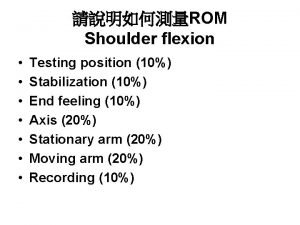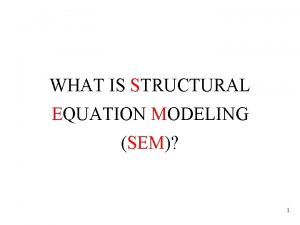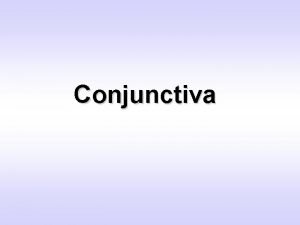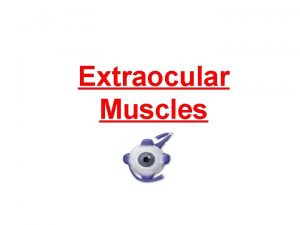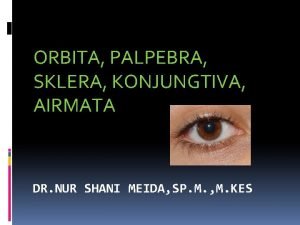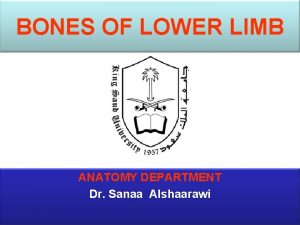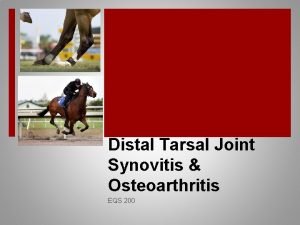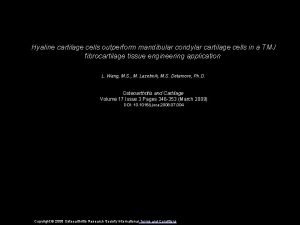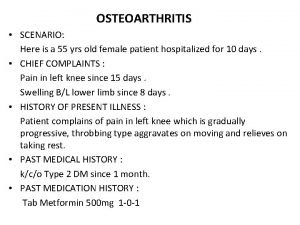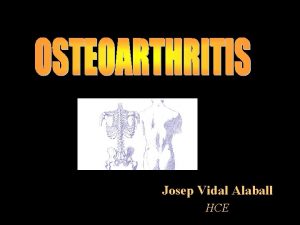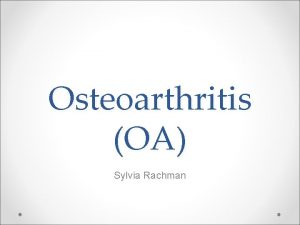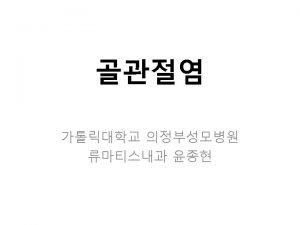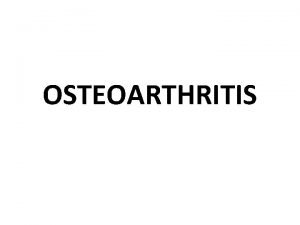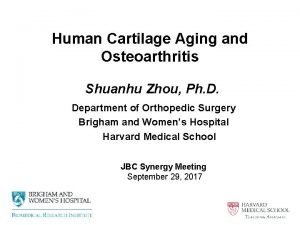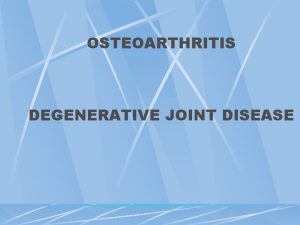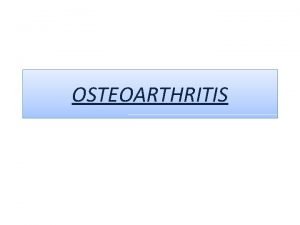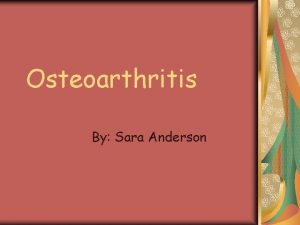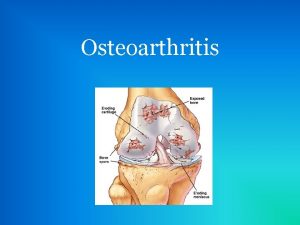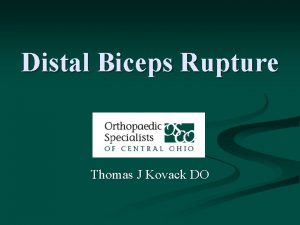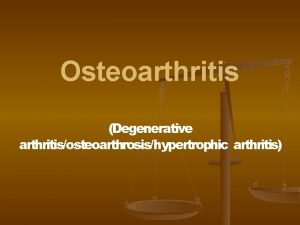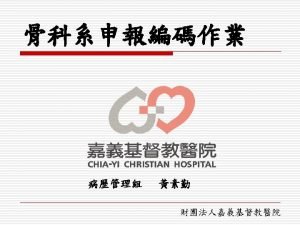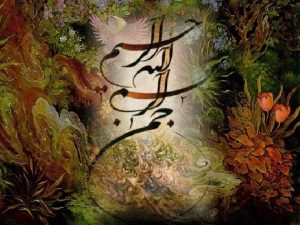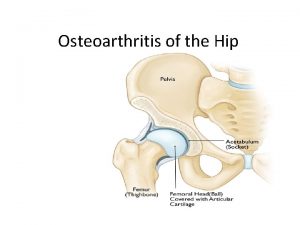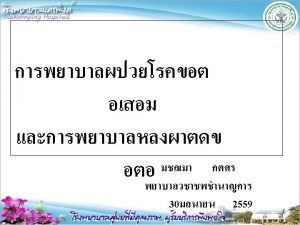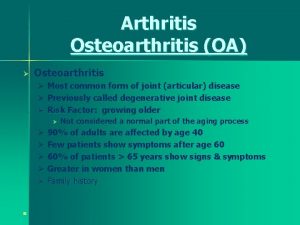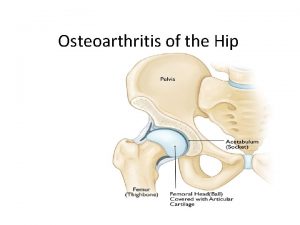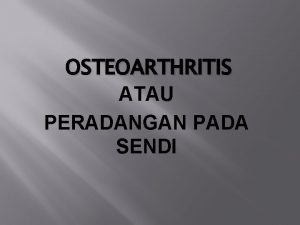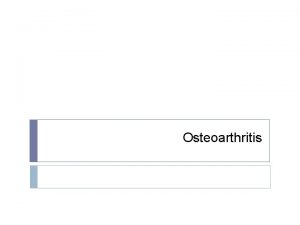Distal Tarsal Joint Synovitis Osteoarthritis EQS 200 The
















- Slides: 16

Distal Tarsal Joint Synovitis & Osteoarthritis EQS 200

The Hock – A Review ¡The most common site for rear limb stress injuries, performance-limiting problems, and pain ¡Receives considerable concussive forces ¡Consists of one large hinge joint and three narrow, horizontal, relatively immobile joints ¡Tibiotarsal joint ¡Proximal intertarsal joint ¡Distal intertarsal joint ¡Tarsometatarsal joint

Distal Tarsal Joint Synovitis & Osteoarthritis ¡So what is it? ¡An Osteoarthritis, or final phase of degenerative joint disease (DJD), in the lower three hock joints § A common cause of hock lameness or pain in all horses § Also called “Bone Spavin” § The term spavin refers to problems in the narrow lower joints in the hocks

The Many Spavins The term Bone Spavin can be further broken down depending on clinical signs § Blind/Occult Spavin § Inability to see or palpate the bony growth § Jack Spavin A bony growth of variable size that pushes out against the overlying tendon § Juvenile Spavin § Seen in young horses § Due to abnormal development of the small cuboidal bones of the hock or incomplete ossification in premature or dysmature foals

Causes This is a Wear and Tear Injury! 1. Cartilage Compression ¡Excessive compression over time can cause the cartilage between the upper and lower surfaces of the lower tarsal bones to become flattened and eroded ¡Joint spaces become narrow, eventually filling with new bone 2. Uneven Loading ¡ Causes excessive compression on the cartilage and bone on one side and strain in the joint capsule and supporting ligaments on the other ¡ Repeated overloading of a joint surface can cause remodeling and new bone production in the form of bone spurs Bony changes such as narrowing of joint space and bone spurs around the joint are indicators of a bone spavin

Contributing Factors ¡Conformation ¡Results in uneven loading of the hocks ¡Cow hocks, in at the hocks, sickle hocked ¡Poor trimming and shoeing ¡Activity ¡Sports that require a lot of hock flexion ¡Excessive concussive forces acting on the hock

§ Subtle, vague, intermittent hindlimb lameness that may shift from one leg to another § Often bilateral § Tend to land toe first and have shorter arc of foot flight § To reduce concussion and hock flexion § Results in dragging of the toe § Hindlimb flexion tests produce temporary worsening of lameness § Advanced cases have bony swelling on the hock, usually on the inside of the joint Clinical Signs

Diagnostic Tools A combination of……. ¡Gait evaluation ¡Flexion tests ¡Radiographs ¡ Unless it is an early spavin or very mild ¡ Will show new bone production (bone spurs) and narrowing of joint spaces ¡ Severity of bony changes does not always match the degree of pain and lameness ¡Scinitigraphy ¡ Good for early or mild cases that show no radiographic evidence ¡Joint Block ¡ Can be difficult due to the lower hock joints being narrow

Examples of Varying Degrees of Distal Osteoarthritis #1

Examples of Varying Degrees of Distal Osteoarthritis #2

Examples of Varying Degrees of Distal Osteoarthritis #3

Treatment No specific treatment due to the changes being irreversible A combination of pain relieving and management changes ¡NSAIDs ¡Corticosteriods ¡ Short-term, anti-inflammatory relief ¡HA and Adequan ¡ Good for mild cases ¡Shoeing ¡ Quicken the breakover and restore hoof balance ¡Training ¡ Should be exercised daily, but reduction of exercise intensity will be necessary

Surgery Natural bone fusion (ankylosis) of the lower two joints can help reduce or eliminate lameness but it can be slow and unpredictable The point of surgical intervention is to accelerate the bone fusion process Surgical Fusion = arthrodesis § Hock Drilling § Destruction of the joint cartilage with a drill bit § Filling holes with bone graft § Chemical § Injection of a caustic substance to destroy cartilage § Laser § Heat the cartilage so cells in the cartilage die, resulting in eventual fusion

Video – Surgical Fusion of Distal Hock Joints

Prognosis Dependent on: ¡ The joints involved ¡ Number of joints affected ¡ Severity of bony changes ¡ How quickly the horse’s condition is worsening ¡ What the horse is used for ¡For horses performing high-level athletic function, prognosis is not good ¡Medical and pain management are key for longevity of both the horse’s career and overall well-bring!

Please use the following password to access Quiz 9 Osteo 2015
 Rom of shoulder
Rom of shoulder Jouni kuha
Jouni kuha 100 200 300
100 200 300 Asymmptomatic
Asymmptomatic Eye movement
Eye movement Anatomi palpebra
Anatomi palpebra Ossification of tarsal bones
Ossification of tarsal bones Osteoarthritis location
Osteoarthritis location Osteoarthritis
Osteoarthritis Osteoarthritis soap note
Osteoarthritis soap note Atlantoaxial osteoarthritis
Atlantoaxial osteoarthritis Generalised osteoarthritis
Generalised osteoarthritis Nodus heberden dan bouchard
Nodus heberden dan bouchard Osteoarthritis grade 3
Osteoarthritis grade 3 Osteoarthritis
Osteoarthritis Osteoarthritis morning stiffness
Osteoarthritis morning stiffness Osteoarthritis
Osteoarthritis
